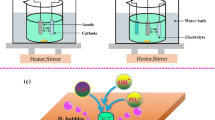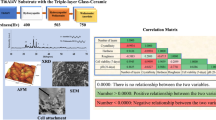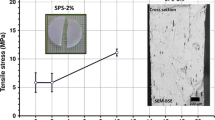Abstract
Modifications were performed on a biomimetic solution (SBF), according to previous knowledge on the behavior of ions present in its composition, in order to obtain apatite coatings onto Ultra-High Molecular Weight Polyethylene (UHMWPE) without having to use polymer pre-treatments that could compromise its properties. UHMWPE substrates were immersed into a 30% H2O2 solution for a 24-h period and then submitted to a biomimetic coating method using standard SBF and two other modified SBF solutions. Apatite coatings were only obtained onto UHMWPE when the modified SBF solutions were used. Based on these results, apatite coatings of biological importance (calcium-deficient hydroxyapatite—CDHA, amorphous calcium phosphate—ACP, octacalcium phosphate—OCP, and carbonated HA) can be obtained onto UHMWPE substrates, allowing an adequate conciliation between bonelike mechanical properties and bioactivity.
Similar content being viewed by others
Explore related subjects
Discover the latest articles, news and stories from top researchers in related subjects.Avoid common mistakes on your manuscript.
1 Introduction
Mechanical properties similar to natural bone tissue, high resistance to abrasion and impact, and a low friction coefficient make Ultra-High Molecular Weight Polyethylene (UHMWPE) a suitable material for bone replacement. This is why it is largely used in total hip, knee, and shoulder prostheses [1–3]. Because it is a bioinert material, its fixation to the bone is only possible by using polymethylmetacrylate (PMMA) bone cements, which are related to severe biological effects, such as necrosis of tissues and release of residual monomers [4]. The conciliation between UHMWPE and a bioactive material would provide adequate conditions for direct bonding of this polymer to the bone and for obtaining a suitable biomaterial for bone replacement, combining bonelike mechanical properties and bioactivity.
The most frequently used bioactive materials that also provide satisfactory bioactivity are calcium phosphate bioceramics, referred to as apatites, which include hydroxyapatite (HA), amorphous calcium phosphate (ACP), and octacalcium phosphate (OCP), among others. In addition to the fact that they are bioactive, these materials are osteoconductors and, depending on their compositions, show differentiated chemical and biological properties, allowing them to be used in conformity with the behavior required for each implementation medium [5–8].
The biomimetic coating method has sparked great research interest because it mimics the biological bone and tooth formation process via the use of a solution with composition, pH, and temperature similar to biological fluids, known as Simulated Body Fluid (SBF). This method allows practically any type of substrate, with any morphology and size, to be coated with a uniform layer of apatite, and allows control over coating characteristics, such as thickness, composition, and crystallinity [9, 10]. The SBF solution contains in its composition ions Ca2+ and PO4 3−, as well as essential trace ions such as Na+, K+, Mg2+, SO4 2−, and HCO3 −, which have specific and differentiated functions. Some of these ions have been reported to be responsible for disturbances in the nucleation and growth of apatites, such as Mg2+ and HCO3 − [11–18].
Because it is a hydrophobic polymer with low chemical reactivity resulting from the fact that the polymer chain is apolar, apatite coatings onto UHMWPE substrates using the biomimetic method can only be obtained by previously modifying the polymer chemically, with the objective of forming hydrophilic functional groups on its surface, which will act as active sites for apatite nucleation. Several UHMWPE modification methods have been reported: ion beam process, oxygen (O2) cluster beam irradiation, ultraviolet (UV) irradiation, and glow discharge (GD). These are methods that require specific technological equipment that can compromise the polymer substrate’s properties as they cause intense oxidation [4, 19, 20].
In the present study, the SBF solution composition was modified in order to allow apatite coatings to be obtained onto the surface of UHMWPE substrates without requiring treatments that could compromise the properties of the polymer. A 30% hydrogen peroxide solution (H2O2) was employed to induce the formation of hydrophilic functional groups onto the surface of the substrates, because it is simpler to use and because of its less aggressive nature on the polymer’s properties.
2 Materials and methods
2.1 Preparation of UHMWPE substrates
UHMWPE substrates were prepared by molding UHMWPE powder (UTEC 6541, Brasken S/A, Brazil) by compression, using a uniaxial press and applying a 5-ton pressure with a metallic mold (1.2 cm in diameter). After being molded, the polymeric substrates were submitted to thermal treatment at 160°C for 1 h. The UHMWPE substrates were ultrasonically washed with acetone and ethanol and dried at room temperature.
2.2 Formation of hydrophilic groups on the polymer surface
To form hydrophilic functional groups on the polymer’s surface, the UHMWPE substrates were immersed in a 30% hydrogen peroxide solution (H2O2) for a 24-h period, at room temperature. After the immersion in H2O2 solution, the specimens were gently washed with distilled water and dried at room temperature.
2.3 Biomimetic coating of UHMWPE substrates
The UHMWPE substrates after the formation of hydrophilic groups in its surface were submitted to the biomimetic coating method using the standard SBF solution and two new SBF solutions with modified compositions, as described in Table 1. The solutions were prepared by dissolving analytical grade reagents into demineralized water and buffered at pH 7.40 with trishydroxymethylaminomethane and 1 M hydrochloric acid. All solutions used were 1.5 times stronger than regular SBF.
The samples were immersed in each SBF solution and maintained at 37°C for a 7-day period. The solutions were replaced every 48 h. After the immersion period, the substrates were removed from the solutions, washed with demineralized water, and dried at room temperature.
2.4 Surface analyses of UHMWPE substrates
The surface of UHMWPE substrate before and after the formation of hydrophobic groups was analyzed by Fourier Transform Infrared Spectroscopy—FT-IR (Spectrum 2000 Perkin Elmer) and contact angle measure (OCA-15 Video-Based Optical Contact Angle Meter, Dataphysics, using demineralized water as liquid for the analysis). For contact angle measure a minimum of three drops were collected at different locations on the sample surface and mean error was reported in Fig. 2.
The surface of substrate after the biomimetic coating method was analyzed by scanning electron microscopy—SEM (Philips XL Series, model XL 30 TMP attached to a spectral analysis system by Energy Dispersive for X-ray—EDX, using gold as conductor material), X-ray diffractometry—XRD (SIEMENS D5000), and Fourier Transform Infrared Spectroscopy—FT-IR (Spectrum 2000 Perkin Elmer).
3 Results
Figure 1 shows the FTIR spectrum of the surfaces of UHMWPE substrates before and after the immersion in H2O2 solution. IR peaks of UHMWPE substrates before immersion were ascribed to C–C bonds (465, 1055 and 1350 cm−1), CH2 groups (725 and 2840 cm−1), C–H bonds (2450–2640 cm−1 and 2900–3300 cm−1), and CH3 groups (1460 and 2900 cm−1), Fig. 1a. IR peaks appeared after the immersion were ascribed to C=C bonds (1545 and 2100–2400 cm−1), C–OH groups (2530 and 3500–3980 cm−1), C=O groups (1875, and 3456–3554 cm−1), and vinylene double bonds (967 cm−1), Fig. 1b.
Figure 2 shows the contact angles of UHMWPE substrates before (a) and after (b) the immersion in H2O2 solution. Before the immersion UHMWPE substrates gave a high contact angle of 112º (a), but the contact angle decreased to around 80º after the immersion (b). These results indicate that the functional groups formed by immersion in H2O2 solution are effective for inducing hydrophilicity on the UHMWPE surface.
Figure 3 shows the surface of the UHMWPE substrate after immersion in the standard SBF solution. The presence of small particles on the UHMWPE surface can be noted in Fig. 3b; however, the EDX spectrum, Fig. 3c, indicates the absence of elements calcium and phosphorus, showed only the element used as conductor material (Au), demonstrating a lack of apatite coating with the use of the standard SBF solution.
Figures 4 and 5 show the UHMWPE substrate surfaces after immersion in the modified SBF solutions 1 and 2, respectively. The formation of apatite coating was observed when both modified SBF solutions were used. The modified SBF solution 1 caused the formation of coating consisting of different apatite phases, as evidenced by the presence of particles with typical morphology of ACP phases, small spherical grains, HA, particles with flower-shaped morphology, and OCP, characterized by perpendicularly oriented crystals, similar to needles [16, 18, 21, 22], Fig. 4a. The presence of elements Ca and P occurred at a 1.57 ratio, Fig. 4b. XRD, Fig. 4c, indicated that the coating obtained consisted of phases ACP, OCP, and calcium-deficient hydroxyapatite—CDHA with formula Ca8.86(PO4)6(OH)2, both of biological importance [23–25]. The FTIR spectrum, Fig. 4d, confirmed the results observed, since it showed bands in the PO4 group at 646, 984, 1144, and 1464 cm−1, and in the P–OH group at 515 and 876 cm−1. The band at 1652 cm−1 was caused by the incorporation of water molecules.
When UHMWPE substrates were immersed into the modified SBF solution 2, a coating consisting of a single apatite phase was obtained, with typical ACP morphology, Fig. 5a. The presence of elements Ca and P occurred at a 1.54 ratio, Fig. 5b. The presence of a CDHA with formula Ca9H2(PO4)6 · nH2O was observed by XRD, which corresponds in composition to the ACP phase [18, 22], together with type AB carbonated apatite (CA and CB), Fig. 5c. The FTIR spectrum, Fig. 5d, showed bands typical of P–OH groups at 1016 cm−1, PO4 at 562 cm−1, and type A carbonated apatite at 1457 and 1528 cm−1. The band at 1636 cm−1 occurred because of the presence of water molecules.
4 Discussions
The use of 30% H2O2 solution resulted in the formation of hydrophilic functional groups on the UHMWPE substrates due to the oxidation process described in Figs. 6 and 7. The interaction between H2O2 solution and UHMWPE leads, through a complex energy transfer, to the scission of C–H bonds, gives vinylene double bonds, H radicals and secondary alkyl macroradicals, in both the crystalline and the amorphous phase of the polymer (Fig. 6). The alkyl macroradicals react promptly with the residual oxygen in the material, triggering the oxidation process widely known under the name of Bolland’s cycle (Fig. 7), giving rise to ketones, alcohols, carboxylic acids and esters, hydrophilic functional groups that were effective for apatite nucleation [26].
The combined presence of Mg2+ and HCO3 − ions on the composition of the standard SBF solution inhibited the crystallization of apatites onto the UHMWPE substrates. Some studies show that Mg2+ and HCO3 − ions cause disturbances in the mechanism of formation of apatites, and are known as apatite nucleation and growth-interfering ions [11–18]. The Mg2+ ion is responsible for inhibiting apatite crystallization when present in the solution at quantities sufficient to compete with Ca2+ ions (Mg/Ca molar ratio higher than 0.05) [16, 17, 20]. The HCO3 − ion is one of the impurity ions that are incorporated into apatites during the hydrolysis process of OCP into HA, and may affect the formation of the latter phase when present in the solution at concentrations higher than 5.0 mMol [16, 17]. Barrére et al. [17] compared the inhibiting effect between Mg2+ and HCO3 − ions on apatite crystallization, and observed longer coating formation periods in solutions with high Mg2+ concentrations than in solutions with the same concentrations of HCO3 −, demonstrating the less pronounced inhibiting effect of the HCO3 − ion. The literature show that apatite coatings on UHMWPE substrates using the standard SBF solution can only be obtained with a previous modification of the polymer’s surface using methods such as ultraviolet irradiation and glow discharge [4], photografting and Vinyltrimethoxysilane hydrolysis (VTMS) [19], and irradiation with the simultaneous use of an O2 cluster and a monomer ions beam [20]. In addition to requiring specific technological equipment, these methods can compromise the polymer’s properties because of the pronounced oxidation that takes place. Based on these observations, it becomes evident that the standard SBF solution composition must be modified to obtain apatite coating onto UHMWPE substrates.
The use of the modified SBF solutions 1 and 2 allowed the formation of apatite coatings on the surface of the UHMWPE substrates due to the modifications made in their compositions. The absence of interfering ions in the composition of the modified SBF solution 1 allowed ACP crystallization and its partial conversion into OCP and from the latter into CDHA, creating a coating that consisted of a mixture of apatite phases. The presence of the HCO3 − ion as the only interfering ion in the composition of the modified SBF solution 2 did not interfere with apatite nucleation, allowing the crystallization and complete conversion of ACP into CDHA, and its incorporation into the HA structure, giving rise to a carbonated HA.
5 Conclusions
Using the biomimetic method to coat the surface of UHMWPE substrates was only suitable when the composition of the standard SBF solution was modified. The composition of the standard SBF solution, together with the presence of ions reported to interfere with apatite crystallization (Mg2+ and HCO3 −), inhibited the formation of apatite coatings. The absence of interfering ions in the composition of modified SBF solution 1 provided the formation of apatite coating onto the UHMWPE surface, consisting of phases with biological importance (ACP, OCP, and CDHA). The presence of the HCO3 − ion as the only interfering ion in the composition of the modified SBF solution 2 did not interfere with apatite crystallization, and a coating consisting of CDHA and carbonated HA was formed. Based on these results it becomes possible to obtain apatite coatings onto UHMWPE without pre-treatments of the substrate that could affect the polymer’s properties, allowing an adequate conciliation between bonelike mechanical properties and bioactivity, thus producing a suitable bone replacement biomaterial.
References
J.B. Park, Lakes RS Biomaterials an Introduction, 2nd edn. (Plenum Press, New York, 1992)
J.W. Nicholson, The Chemistry of Medical and Dental Materials, 1st edn. (Royal Society of Chemistry, Cambridge, 2002)
M.B. Turell, A. Bellare, Biomaterials 25, 3389 (2004)
K.C. Baker, J. Drelich, I. Miskioglu, R. Israel, H.N. Herkowitz, Acta Biomater. 3, 391 (2007)
H. Aoki, Science and Medical Applications of Hydroxyapatite (JAAS, Tokio, 1991)
A.A. Campbell, Mater. Today 6, 26 (2003)
L.L. Hench, J.R. Jones, Biomaterials, Artificial Organs and Tissue Engineering (CRC Press, Boca Raton, 2005)
E.Y. Kawachi, C.A. Bertran, R.R. dos Reis, O.L. Alves, Quim. Nova 23, 518 (2000)
Y. Abe, T. Kokubo, J. Mater. Sci. Mater. Med. 1, 239 (1990)
T. Kokubo, Termochimica Acta 280/281, 479 (1996)
A.H. Aparecida, M.V.L. Fook, M.L. dos Santos, A.C. Guastaldi, Quim. Nova 30, 2072 (2007)
A.H. Aparecida, M.V.L. Fook, M.L. dos Santos, A.C. Guastaldi, Eclética Quím. 30, 13 (2005)
E.A.P. Maeyer, J. Cryst. Growth 169, 539 (1996)
N. Kanzaki, K. Onuma, G. Treboux, S. Tsutsumi, A. Ito, J. Phys. Chem. 104, 4189 (2000)
M. Iijima, H. Kamemizu, N. Wakamatsu, T. Goto, Y. Doi, Y. Moriwaki, J. Cryst. Growth 135, 229 (1994)
F. Barrere, P. Layrolle, C.A.V. Blitterswijk, K. Groot, Bone 25, 107S (1999)
F. Barrere, C.A.V. Blitterswijk, K. De Groot, P. Layrolle, Biomaterials 23, 2211 (2002)
T. Kanazawa, Inorganic Phosphate Materials (Elsevier, Amsterdam, 1989)
H.-M. Kim, M. Uenoyama, T. Kokubo, M. Minoda, T. Miyamoto, T. Nakamura, Biomaterials 22, 2489 (2001)
M. Kawashita, S. Itoh, R. Araki, K. Miyamoto, G.H. Takaoka, J. Biomed. Mater. Res. A 82, 995 (2007)
S. Graham, P.W. Brown, J. Cryst. Growth 165, 106 (1996)
R.J. Dekker, J.D. Bruijn, M. Stigter, F. Barrere, P. Layrolle, C.A.V. Blitterswijk, Biomaterials 26, 5231 (2005)
M. Vallet-Regi, J.M.G. Calbet, Prog. Solid State Chem. 32, 1 (2004)
M. Julien, I. Khairoun, R.Z. LeGerosc, S. Delplace, P. Pilet, P. Weissb, G. Daculs, J.M. Bouler, J. Guicheux Biomater. 28, 956 (2007)
H. Imaizumi, M. Sakurai, O. Kashimoto, T. Kikawa, O. Suzuki, Calcif. Tissue Int. 78, 45 (2006)
L. Costa, M.P. Luda, L. Trossarelli, E.M.B. del Prever, M. Crova, P. Gallinaro Biomaterials 19, 659 (1998)
Acknowledgments
The authors thank FAPESP (Proceeding no. 06/60436-3) for financial support.
Author information
Authors and Affiliations
Corresponding author
Rights and permissions
About this article
Cite this article
Aparecida, A.H., Fook, M.V.L. & Guastaldi, A.C. Biomimetic apatite formation on Ultra-High Molecular Weight Polyethylene (UHMWPE) using modified biomimetic solution. J Mater Sci: Mater Med 20, 1215–1222 (2009). https://doi.org/10.1007/s10856-008-3682-0
Received:
Accepted:
Published:
Issue Date:
DOI: https://doi.org/10.1007/s10856-008-3682-0











